When I first started researching corded petticoats, I realized I must start with what the fashion silhouette looked like at the time. This always begs the question: Which came first – the fashion or the undergarments?
So I pondered on why the skirts “belled” the way they did, how they stuck out at the hips, and why they looked so heavy. I found only a few resources online but scoured Google and reenacting forums in which I gathered enough information to know how to create that Early Victorian look.
To begin, after the Prince Regent was crowned in 1820, and before Victoria was crowned Queen of England in 1837, these seventeen years came to be known as the Romantic Era. Of course these are not inclusive dates, as fashion does not change, literally, overnight.
Poetry by Poe and Longfellow became popular, and early romantic music written by Beethoven and Chopin shaped social events. I can just envision listening to Chopin play a magical concerto while I’m dressed in a 1840s evening gown.
The slender lines of Regency fashions in the late 1810s started to flare out – both at the shoulders and the hems. The huge gigot sleeve developed in the late 1820s and became even bigger in the 1830s, and panels were added to skirts to increase width. Waistlines began to drop rapidly, from high under the bust around 1817 to just above the natural waist by the late 1820s.
Queen Victoria, an icon of fashion trends, embraced romantic, feminine lines, demure in looks and submissive in the downward pointing hair, shoulder line and pointed bodices, all popular in the 1840s.
The Undergarments
The wired crinoline, or hoop skirt, was first patented in the mid-1850s (1856). Thin spring steel rows were attached to twill tapes hanging vertically from a waistband. The freedom women felt to be rid of multiple layers of petticoats must have been a great blessing.
But before then, women generally layered up to 5 petticoats at once. Can you imagine all those layers? The corded petticoat or crinoline was the 2nd layer out from the skin. A narrow under-petticoat was the first layer next to the legs.
Below are a few fashion plates of the era. If you are making a costume from the 1830s thru ’50s, look closely at the skirt shapes of fashion plates, existing garments and photographs to layer your petticoats as needed for the desired look.
As the slim skirts of the Regency started to be cut out in shaped panels to widen the hem, petticoats started to be worn to help hold the skirt out. This clearly shows later 1820s fashion with the larger gigot sleeves and hemline. Notice that her skirt waistline is flat around.
Here we see more fullness at the waist due to additional petticoats that sit at the waistline. Such a soft bell shape!
Throughout the 1830s skirts continued to widen. Several layers of petticoats began to be worn, including a corded petticoat or crinoline made with horsehair.
Notice how the bell shape has now kicked out more at the hem. You betcha there are ruffled petticoats under her skirt!
By the 1840s and throughout the 1850s, so many petticoat layers were worn that the skirts took on a distinct dome shape. Ruffles were added to skirts to assist in the visualization of wider skirt hems and narrow waistlines.
The wired cage crinoline was invented in June 1856. As you can see in the 1855 Godey’s plate, the skirts are very full but fold softly at the hem. You can tell they have a few petticoats under those skirts but no wired one – yet!
As with all fashion, the corded petticoat did not disappear right away. However, with the freedom of movement and less weight provided by the caged hoop skirt, I’m sure women would have adopted the new undergarment quickly. Wouldn’t you?
Do you sew Romantic Era fashions? How many petticoats do you wear to create the silhouette?

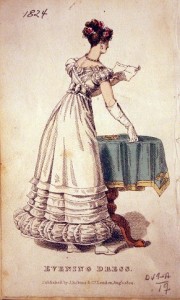
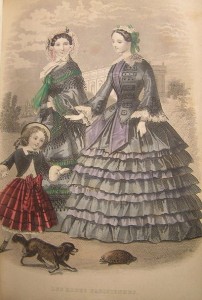
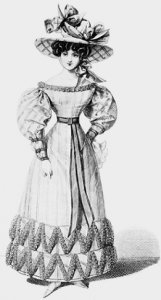
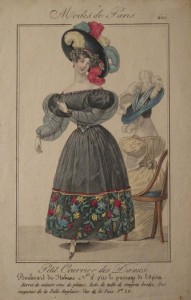
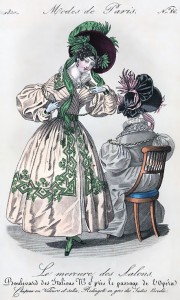
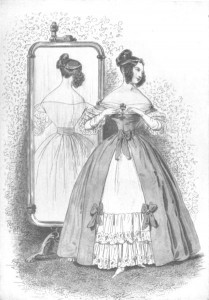
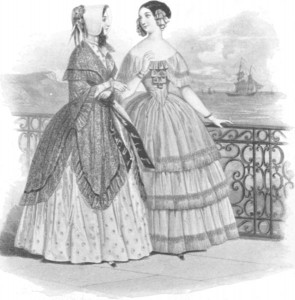
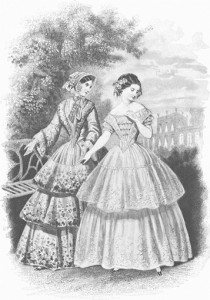
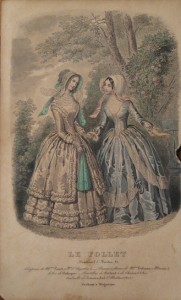
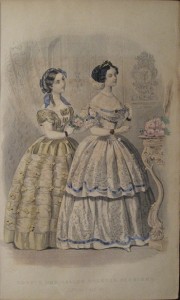
The more the better!
If I’m wearing a thick wool petticoat (a nust rigeur if I’m working around fires) I can get by with three. Otherwise, 4 or 5. But I suspect that if you starched them until they could stand up on their own, you could do with less. I’m just not into all the ironing that requires!
I wear 4 to 5, depending on the weather.